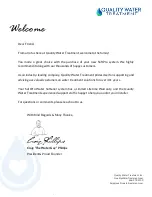
INSTALLATION
Connect system pipe to port on tank cover flange. Use plastic or
steel pipe as required. To prevent leaks, use Teflon tape or Plasto-
Joint St k
1
on male threads of all threaded connections to tank.
Flush all air out of piping system and water reservoir portion of pre-
charged tank. Required on: new installations, pumps requiring
repriming and pumps disassembled for service. Do as follows:
1. Open faucets furthest from tank and run pump.
2. Allow pump to run until sputtering stops and steady stream of
water runs.
3. Open and close faucets repeatedly until sure all air has been
removed.
4. If stream does not become steady, air may be leaking into sys-
tem; check for leaks in piping on suction side of pump.
NOTICE: To prevent waterlogging, check tank air charge annually.
STANDARD TANK REPLACEMENT
When replacing standard tank in water system with pre-charged
tank, no bleeder orifices or Air Volume Control (AVC) are required.
Hazardous voltage and hazardous pressure.
Disconnect all power to pump and bleed all pressure from sys-
tem before working on pump, tank, or piping.
For jet pump installation, remove AVC tube from port in pump body
or jet body and plug port (see Fig. 3).
MAINTENANCE
In areas where temperature is high for long periods of time, tank
pre-charge pressure may increase. This may reduce tank drawdown
(amount of water available per cycle). If this occurs, reduce pre-
charge pressure to 2 PSI (14kPa) below pump ON pressure setting.
TO CHECK TANK AIR CHARGE
If drawdown decreases significantly, check as follows:
1. To check air charge in tank, shut off electric power to pump, open
faucet near tank, and drain completely.
2. At air valve, check air pressure with tire gauge. Pressure should
be 2 PSI (14kPa) below pump ON pressure setting.
3. If air pressure is more than 2 PSI (14kPa) below the ON setting,
add air to tank. Use air compressor or portable air storage tank.
4. Use soap or liquid detergent to check for air leaks around air
valve. Continuous bubbling indicates leak. If necessary, install
new core in air valve, (same as used for automobile tubeless
tires.)
TESTING FOR BLADDER LEAKAGE
1. Disconnect power to pump.
2. Drain water from tank bladder by opening faucet closest to tank.
3. Remove valve cap and release all pressure by depressing valve
core. When air stops coming from valve, remove valve core to
release remaining pressure.
4. Disconnect piping from elbow on tank cover flange.
5. Carefully turn tank upside down or lay on its side.
Retained water in tank may cause sudden
weight shift when lowering. Support tank so it cannot fall
when being lowered or inverted.
6. If bladder leaks, water will run out of valve. If so, replace bladder.
7. If replacing bladder, be sure air and water pressures are relieved
before removing cover flange. When reassembling cover flange,
do not tighten nuts or mounting studs more than 85 in- bs. (9.6
Nm).
1
Lake Chemical Co., Chicago, IL
3
English
148 0893
Figure 3 – Plug AVC Port
when installing
pre-charged tank.
Summary of Contents for FP7300
Page 9: ......



























